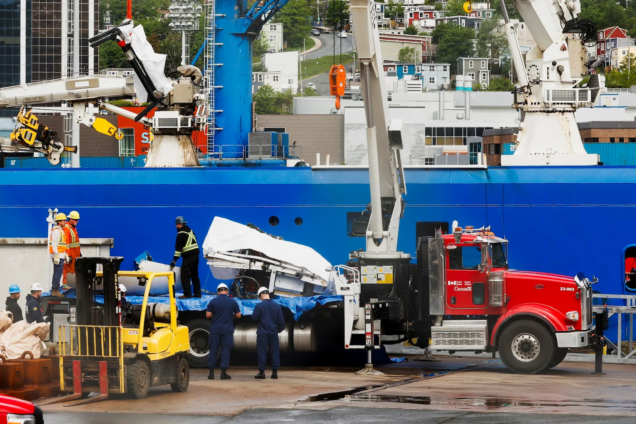29th June, 2023
Presumed human remains and debris from the imploded OceanGate submersible were found from the ocean floor and transported onshore to Canada.
The US Coast Guard confirmed on Wednesday evening.
According to the Coast Guard, the potential remnants and shattered fragments of the submersible Titan, which was wrecked while diving to the century-old Titanic wreck, were transported to St. John’s, Newfoundland, roughly 400 miles (650 km) north of the accident site, by the Canadian-flagged vessel Horizon Arctic.
It will be transferred by a Coast Guard cutter to a U.S. port for analysis and testing by a marine board of investigation, which was constituted by the Guard this week to conduct a formal probe into the Titan’s loss.
In addition, US medical personnel will “conduct a formal analysis of presumed human remains that have been carefully recovered within the wreckage at the site of the incident,” according to the Coast Guard statement.
The nature and extent of possible site remains were not specified.
A crane lifted what looked to be the nose of the submersible and other smashed bits wrapped in white sheet from the deck of the Horizon Arctic on Wednesday morning.
A smashed section of the Titanic’s hull and machinery with dangling wires were also seen being removed from the ship at St. John’s, where the Titanic expedition had begun.
The examination of the debris is expected to offer more insight on the origin of the tragic implosion that wrecked the Titan earlier this month while the 22-foot craft was transporting five tourists to the Titanic shipwreck in the North Atlantic.
The Transportation Safety Board (TSB) of Canada, which is conducting its own investigation, announced that its inspectors had concluded preliminary interviews with the crew of Titan’s Canadian-flagged surface support vessel, Polar Prince, and had seized that ship’s trip data recorder.
The TSB also stated that it “inspected, documented, and catalogued” all materials retrieved from the accident scene before turning them over to US authorities.
Fragments of the submersible, which had lost touch with Polar Prince approximately one hour and 45 minutes into a two-hour descend on June 18, were discovered littered the seafloor about 1,600 feet (488 metres) from the bow of the Titanic wreck four days later.
The finding by a robotic deep-sea diving vehicle scouring the ocean floor more than 2 miles (3 kilometres) underwater brought an end to a global search that drew worldwide media interest and confirmed the fate of the five persons aboard.
Stockton Rush, the submersible pilot and CEO of OceanGate Expeditions, which owned and operated the Titan, was killed. British billionaire Hamish Harding, 58, and his 19-year-old son Suleman were also killed, as was French oceanographer Paul-Henri Nargeolet, 77.
The disaster has prompted concerns about the unregulated nature of such expeditions, as well as OceanGate’s choice to skip third-party industry study and certification of Titan’s innovative design.
“Our team has successfully completed off-shore operations but is still on mission and will be in the process of demobilisation from the Horizon Arctic this morning,” said Pelagic Research, which controls a robotic vehicle involved in the debris recovery.
Reuters



